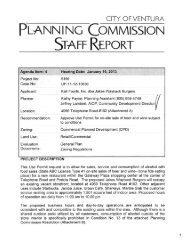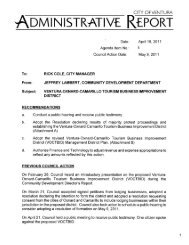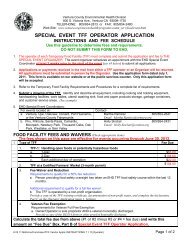Saticoy & Wells Community Plan & Development ... - City Of Ventura
Saticoy & Wells Community Plan & Development ... - City Of Ventura
Saticoy & Wells Community Plan & Development ... - City Of Ventura
You also want an ePaper? Increase the reach of your titles
YUMPU automatically turns print PDFs into web optimized ePapers that Google loves.
<strong>Saticoy</strong> & <strong>Wells</strong> <strong>Community</strong> <strong>Plan</strong> and Code EIRSection 4.2 Agricultural Resources4.2 AGRICULTURAL RESOURCESThis section analyzes the impacts of development accommodated under the <strong>Saticoy</strong> & <strong>Wells</strong><strong>Community</strong> <strong>Plan</strong> and Code upon agricultural resources. Both direct impacts relating to thepotential conversion of agricultural lands and indirect effects associated with placing urbandevelopment adjacent to agriculture are addressed.4.2.1 Settinga. General Setting. Agriculture plays an important role in the economy of <strong>Ventura</strong>County and the <strong>City</strong> of <strong>Ventura</strong>. <strong>Ventura</strong> County is one of the principal agricultural counties inthe state. In 2007, the total value of agriculture production for the County was $1.550 billion, anincrease of $41.8 million from 2006 (<strong>Ventura</strong> County Crop Report, 2007). This level ofproduction is made possible by the presence of high quality soils, adequate water supply,favorable climate, long growing season, and level topography. In 2007, the top five cash cropsin the County were strawberries, nursery stock, lemons, raspberries, and avocados. Nurserystock and cut flowers are of increasing importance to local agricultural production.b. Project Area Agriculture. The majority of the soils in the ProjectArea were at onetime considered suitable for intensive farming. Most of the Project Area has been developed(approximately 60%) and no longer supports farming operations. Approximately 300 acres, or30% of the Project Area, remain in row crop operations or are otherwise undeveloped and havesoils suitable for agricultural use. In addition to row crops, portions of the Project Area areused for orchard production. Table 4.2-1 lists the existing sites used for agriculture as well asthe estimated acreage of “Prime” and “Statewide” Important Farmland.Important Farmlands. The U.S. Soil Conservation Service Important FarmlandsInventory (IFI) system is used to inventory lands with agricultural value. This system dividesfarmland into classes based on productive capability of the land (rather than the mere presenceof ideal soil conditions). The major classifications for farmlands are described below.• “Prime” farmlands in California are irrigated soils (Class I and II) over 40 inchesdeep with an available water-holding capacity of four inches or more. They aregenerally well drained and free from frequent flooding. Soil reaction is neitherextremely acid nor strongly alkaline. The erosion hazard is slight and farming is notlimited by cobbly surface layers, slow subsoil permeability, or freezing soiltemperatures.• Farmlands of “statewide” importance are lands other than “prime” that have a goodcombination of physical and chemical characteristics to produce food, feed, forage,fiber, and oil seed crops. The criteria are like that for “prime” except that nominimum soil depth limitation or permeability restriction exists. “Statewide”farmlands have broader waterholding capacity, soil reaction, may be slightly saline oralkali affected, and may have a slight erosion hazard.• “Unique” farmlands are additional lands that produce high value food and fibercrops, as listed in the annual report of the Department of Food and Agriculture.4.2-1<strong>City</strong> of <strong>Ventura</strong>
















